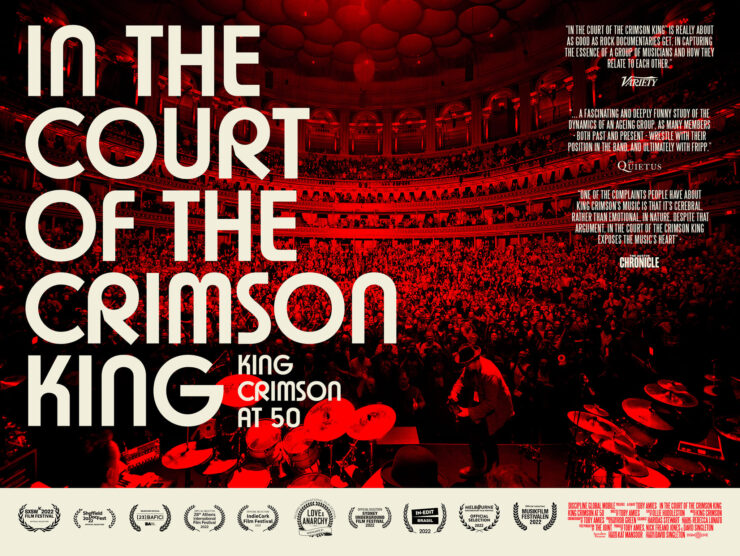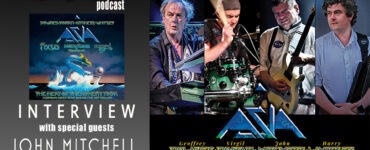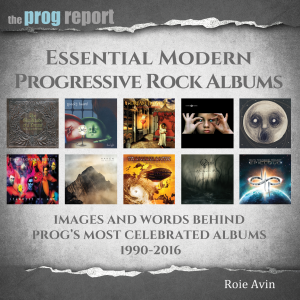by Geoff Bailie
When it comes to historical back catalogue, there really isn’t a band like King Crimson – DGM’s incredible series of box sets catalogue beyond comparison (the albums, sessions and live performances of the band) are lavish explorations of the eras. And yet, if you’re looking for a video history of the band similar to The Beatles’ Anthology, The Stones’ Crossfire Hurricane, Kansas’ Miracles Out of Nowhere or multiple Yes documentaries, there hasn’t ever been one. And there still isn’t.
Soon to be released in its own lavish box set, Toby Amies’s In “The Court of the Crimson King – King Crimson at 50” got an early release in October 2022 as a live stream (and cinema preview), allowing fans everywhere to see the documentary that has so far only been seen in some film festivals. Those early previews have gathered rave reviews so, as a big KC fan and owner of the aforementioned box sets, I was happy to sign up for the stream – and was glad I did.
Let me clear things up at the start – this isn’t a chronology of the band. Yes, you will glean the broad story/ history of the band from watching it, but, for example, almost none of the band’s albums are referred to by name. It’s also not an in depth review or analysis of the band’s music – the music is present, almost constantly in the movie. There is practically no discussion of individual songs, but by the time the credits role, you’ll see (whether you noticed it or not) that just about every significant catalogue song has featured.
So what is it about? The documentary is about Musicians and the performance of Music. Of course, Robert Fripp and his outlook and philosophies are central to the documentary as they are to the band. Fripp is honest about himself and appears to be very self aware of how he is viewed, which in some cases isn’t necessarily positively. Founding member Ian McDonald apologises for breaking Robert’s heart by leaving the band – yet Michael Giles who left at the same time largely attributes his departure as an act of self preservation. More outspoken are Trey Gunn and Adrian Belew – by the time the latter appears to give his account, the viewer will have gathered the significant gulf between the contrasting philosophies of Fripp and Belew. Perhaps the person with the broadest perspective is the delightful Mel Collins, whose presence in a 1970s and a post 2014 line up allows him to contrast but also explain the consistency. This swirling group of opinions and perspectives make for very interesting viewing and I suspect that even a more casual fan, or even non-fan, will find it fascinating.
I’ve mentioned “philosophies” a few times and Fripp’s outlook, perspective and reasons for doing things always appear to be very considered and principled. Presenting this in a documentary runs the risk of turning it into a lecture – but what Toby Amies has constructed here deals with that perfectly. Indeed, many of the principles are presented in such a way that I was finding myself thinking about their applications beyond the world of a professional musician. Recent Crimson gigs are famous for their “No Cameras until the end” rule and that stems from the view that both the musicians and the band must be fully present for the performance to be complete. In a world of digital (and other) distraction, that’s something we can all associate with. Even in the simple area of music listening – with availability and portability, how often does music listening become part of “the background noise” of the day? Sitting down to watch a band documentary, I wasn’t expecting to take that away – and it’s one element of what makes this piece so great.
The movie also focuses on the Audience and the importance of their role. Of the fans who are featured, each sound bite is included to give the viewer a better understanding of what the fans are experiencing – some of those express this verbally … others more anonymously demonstrated by being included in some candid footage filmed during shows of their participation. And… well I don’t want to spoil it but… wait for the contribution of the Crimson fan who is a nun – definitely an unexpected highlight.
While the majority of the final line up’s members contribute it’s interesting that Gavin Harrison, whose role included being the main arranger, is featured less than Jakko, Tony, Mel and Jeremy. Instead, a lot of time is spent with Bill Rieflin, whose uniqueness is such that he’s described as the only band member who was a friend of Fripp before he joined. Bill passed away in 2020 and a lot of the documentary was filmed on Bill’s final trip out with the band, at a time when he knew what his prognosis was. Again no spoilers but the soul outpouring that Rieflin contributes to this documentary is challenging and moving… as is … and again being as spoiler free as possible… what was described by Toby Aimes in the post stream Q&A as: “The Mega Pause” is an amazing moment.
In conclusion, as and when this becomes more widely available, I’d really encourage readers (or indeed any musician or fan of music, Crimson fan or not) to see this documentary. It is funny and thought provoking in many ways – and I certainly hope it sparks your thoughts the way it did mine.








Belew has recently stated that he felt unfairly edited – that there were positives from him that would have provided more balance to his testimony.